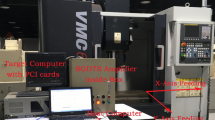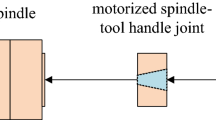Abstract
Stick–slip is a negative phenomenon caused by friction in servo feed systems, which is particularly prominent in low-speed and heavy-load conditions. At present, most research on the critical Stick–slip velocity ignores higher-order terms of the equivalent damping ratio; the calculation accuracy is greatly reduced when the system has a large equivalent damping ratio. To solve it, firstly, an improved Stribeck model based on the least squares genetic algorithm is proposed for friction identification; meanwhile, the identification of shape parameters of the traditional Stribeck model is extended instead of empirical values. Then, an improved method of the critical Stick–slip velocity based on the dynamic model is constructed, and the influence of the higher-order term of the equivalent damping ratio on the critical velocity identification accuracy is analyzed. Finally, this method is verified by the computerized numerical control end-face cylindrical grinder with a hard guideway. The friction force identification error of the proposed method is reduced by 10% compared with the traditional method, and the error of the critical Stick–slip velocity by retaining the higher-order term is reduced by 37% compared with the critical Stick–slip velocity by ignoring the higher-order term.
















Similar content being viewed by others
Data availability
Data related to this work will be provided upon request.
Code availability
Part of the code can be provided upon request for noncommercial purposes.
References
Wang DW, Mo JL, Zhang Q, Zhao J, Ouyang H, Zhou ZR (2017) The effect of the grooved elastic damping component in reducing friction-induced vibration. Tribol Int 110:264–277. https://doi.org/10.1016/j.triboint.2017.02.031
Saha A, Wiercigroch M, Jankowski K, Wahi P, Stefáski A (2015) Investigation of two different friction models from the perspective of friction-induced vibrations. Tribol Int 90:185–197. https://doi.org/10.1016/j.triboint.2015.04.029
Liu N, Ouyang H (2019) Friction-induced vibration of a slider on an elastic disc spinning at variable speeds. Nonlinear Dyn 98:39–60. https://doi.org/10.1007/s11071-019-05169-1
Guran A, Pfeiffer F, Popp K (2001) Dynamics with friction: modeling, analysis and experiment. World Scientific
Daniel RW (1992) Control of machines with friction. Springer Science & Business Media, Brian Armstrong-Hélouvry
Oestreich M, Hinrichs N, Popp K (1996) Bifurcation and stability analysis for a non-smooth friction oscillator. Arch Appl Mech 66:301–314. https://doi.org/10.1007/BF00795247
Dupont PE (1991) Avoiding Stick-slip in position and force control through feedback. In: Proceedings - IEEE International Conference on Robotics and Automation. IEEE Computer Society, pp 1470–1475
Pratt TK, Williams R (1981) Non-linear analysis of stick/slip motion. J Sound Vib 74:531–542
Juel Thomsen J, Fidlin A (2003) Analytical approximations for Stick-slip vibration amplitudes. Int J Non Linear Mech 38:389–403. https://doi.org/10.1016/S0020-7462(01)00073-7
Khulief YA, Al-Sulaiman FA, Bashmal S (2007) Vibration analysis of drillstrings with self-excited Stick-slip oscillations. J Sound Vib 299:540–558. https://doi.org/10.1016/j.jsv.2006.06.065
Liu Y, Chen Z, Tang L, Zhai W (2021) Skidding dynamic performance of rolling bearing with cage flexibility under accelerating conditions. Mech Syst Signal Process 150:107257. https://doi.org/10.1016/j.ymssp.2020.107257
Sinou JJ, Dereure O, Mazet GB, Thouverez F, Jezequel L (2006) Friction-induced vibration for an aircraft brake system - Part 1: experimental approach and stability analysis. Int J Mech Sci 48:536–554. https://doi.org/10.1016/j.ijmecsci.2005.12.002
Liu W, Zhang S, Lin J, Xia Y, Wang J, Sun Y (2022) Advancements in accuracy decline mechanisms and accuracy retention approaches of CNC machine tools: a review. Int J Adv Manuf Technol 121:7087–7115. https://doi.org/10.1007/s00170-022-09720-0
Gao X, Zhang X, Yang J, Fu Z, Wang M, Zan T (2023) Dynamic modeling and analysis on lateral vibration of ball screw feed system. Int J Adv Manuf Technol 124:4211–4229. https://doi.org/10.1007/s00170-022-09525-1
Bowden FP, Bowden FP, Tabor D (1964) The friction and lubrication of solids part II. Oxford University Press
Black J, Voorhees W (1977) Theory of linear continuous extrusion linex. Am Soc Mech Eng
Capone G, D’Agostino V, Della VS, Guida D (1993) Influence of the variation between static and kinetic friction on Stick-slip instability. Wear 161:121–126. https://doi.org/10.1016/0043-1648(93)90460-4
Yoshizawa H, You-Lung C, Israelachvili J (1993) Recent advances in molecular level understanding of adhesion, friction and lubrication. Wear 168:161–166. https://doi.org/10.1016/0043-1648(93)90212-5
Armstrong-Hélouvry B, Dupont P, De Wit CC (1994) A survey of models, analysis tools and compensation methods for the control of machines with friction. Automatica 30:1083–1138. https://doi.org/10.1016/0005-1098(94)90209-7
Olsson H, Åström KJ, Canudas De Wit C, Gäfvert M, Lischinsky P (1998) Friction models and friction compensation. Eur J Control 4:176–195. https://doi.org/10.1016/S0947-3580(98)70113-X
Awrejcewicz J, Olejnik P (2005) Analysis of dynamic systems with various friction laws. Appl Mech Rev 58:389–410. https://doi.org/10.1115/1.2048687
Mostaghel N, Davis T (1997) Representations of Coulomb friction for dynamic analysis. Earthq Eng Struct Dyn 26:541–548. https://doi.org/10.1002/(SICI)1096-9845(199705)26:5%3c541::AID-EQE660%3e3.0.CO;2-W
Niranjan P, Karinka S, Sairam KVSSSS, Upadhya A, Shetty S (2018) Friction modeling in servo machines: a review. Int J Dyn Control 6:893–906. https://doi.org/10.1007/s40435-017-0353-3
Liang JW (2005) Identifying Coulomb and viscous damping from free-vibration acceleration decrements. J Sound Vib 282:1208–1220. https://doi.org/10.1016/j.jsv.2004.04.034
Liang M, Zhou D (2022) A nonlinear friction identification method combining separable least squares approach and kinematic orthogonal property. Int J Precis Eng Manuf 23:139–152. https://doi.org/10.1007/s12541-021-00611-0
Yeh SS (2011) Development of friction identification, modeling, and compensation methods for feed drive motions of CNC machine tools. In: Industrial Control Systems. Nova Science Publishers, Inc., pp 1–60
Li FT, Ma L, Mi LT, Zeng YX, Jin NB, Gao YL (2017) Friction identification and compensation design for precision positioning. Adv Manuf 5:120–129. https://doi.org/10.1007/s40436-017-0171-z
Lee CY, Hwang SH, Nam E, Min BK (2020) Identification of mass and sliding friction parameters of machine tool feed drive using recursive least squares method. Int J Adv Manuf Technol 109:2831–2844. https://doi.org/10.1007/s00170-020-05858-x
Sparham M, Sarhan AAD, Mardi NA, Dahari M, Hamdi M (2016) Cutting force analysis to estimate the friction force in linear guideways of CNC machine. Meas J Int Meas Confed 85:65–79. https://doi.org/10.1016/j.measurement.2016.02.017
Liu D, Wang G, Nie Z, Rong YK (2016) An in-situ infrared temperature-measurement method with back focusing on surface for creep-feed grinding. Meas J Int Meas Confed 94:645–652. https://doi.org/10.1016/j.measurement.2016.09.013
Hieu NN, Chung PN (2021) Analysis of stability and Stick-slip motion of a friction-induced vibrating system with dwell-time effect. Int J Mech Sci 205:106605. https://doi.org/10.1016/j.ijmecsci.2021.106605
Wang S, Hong L, Jiang J (2021) Analytical prediction on Stick-slip whirling oscillations induced by dry friction between a rotating imbalanced rotor and a flexibly supported stator. J Sound Vib 511:116333. https://doi.org/10.1016/j.jsv.2021.116333
Mfoumou GS, Kenmoé GD, Kofané TC (2019) Computational algorithms of time series for Stick-slip dynamics and time-delayed feedback control of chaos for a class of discontinuous friction systems. Mech Syst Signal Process 119:399–419. https://doi.org/10.1016/j.ymssp.2018.09.034
Bilkay O, Anlagan O (2004) Computer simulation of Stick-slip motion in machine tool slideways. Tribol Int 37:347–351. https://doi.org/10.1016/j.triboint.2003.11.006
He Y, Fu Y, Wang H, Yang J (2021) Inhibiting mechanism of micro dimples on the Stick-slip of sliding guideway: combined numerical analysis with tribological tests. Tribol Int 162:107144. https://doi.org/10.1016/j.triboint.2021.107144
Funding
This paper is supported by the National High-Quality Development Project of China (no. TC210H03A-04) and the Major Science and Technology Projects of Hubei Province (no. 2020AGA018).
Author information
Authors and Affiliations
Contributions
Jianzhong Yang: resources and project administration. Hao Zhou: formal analysis, methodology, investigation, and writing—original draft. Shuo Li: data curation and software. Jihong Chen and Hua Xiang: conceptualization and supervision.
Corresponding author
Ethics declarations
Conflict of interest
The authors declare no competing interests.
Additional information
Publisher's Note
Springer Nature remains neutral with regard to jurisdictional claims in published maps and institutional affiliations.
Rights and permissions
Springer Nature or its licensor (e.g. a society or other partner) holds exclusive rights to this article under a publishing agreement with the author(s) or other rightsholder(s); author self-archiving of the accepted manuscript version of this article is solely governed by the terms of such publishing agreement and applicable law.
About this article
Cite this article
Yang, J., Zhou, H., Li, S. et al. Analysis of the critical Stick–slip velocity of CNC machine tool combining friction parameters identification and dynamic model. Int J Adv Manuf Technol 131, 1849–1865 (2024). https://doi.org/10.1007/s00170-024-13202-w
Received:
Accepted:
Published:
Issue Date:
DOI: https://doi.org/10.1007/s00170-024-13202-w




